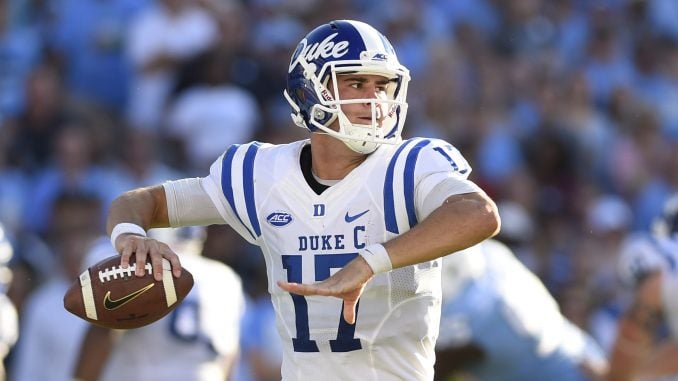
Duke quarterback Daniel Jones redshirted his first year in Durham, getting to learn the system in a relatively low-pressure environment.
That all changed the following year. Jones entered fall camp expecting to ease into the position behind senior starter Thomas Sirk. Instead, Sirk went down early in preseason practice, and Jones suddenly found himself starting for the Blue Devils.
He had moments of success, moments of confusion and moments where he was running for his life.
Two very different learning environments, but there’s no question in Jones’ mind which was the more valuable.
“You definitely learn the most when you’re playing out there on the field,” Jones said. “You can learn a lot by watching, but there’s nothing more valuable than experience and doing it yourself.”
In the history of college football, coaches have faced that either-or proposition with talented young players: Trial by fire or don the redshirt?
That all changes this year. In a new NCAA rule that was initiated, players can participate in up to four games and still count the year as a redshirt.
“The opportunity to have limited game experience without penalty … should be an overall benefit to the game, the players and the coaches,” said ACC commissioner John Swofford. “As a former player who sat out a year with an illness and spent that year not playing the game, that’s a tough thing to do.”
Jones certainly would have benefitted from the rule during his redshirt year.
“It would have been huge,” he said. “I think that’s very valuable for those guys (this year) to have that opportunity. I think even getting in at the end of games and getting snaps would be valuable experience.”
Across the Triangle, NC State quarterback Ryan Finley is also a fan of the rule. He’s seen on State’s offensive line how valuable a few games of experience can be. Gone this season are right guard Tony Adams and right tackle Will Richardson. Guard Josh Fedd-Jackson and tackle Justin Witt, both sophomores, will get first crack at replacing them.
Luckily for them, and for Finley’s health, Fedd-Jackson and Witt both saw playing time last season.
“The great thing about it is they’ve played a lot in games, which is a big thing. … With Fedd playing in the bowl game and Witt starting two games last season, that’s a big deal.” Finley said. “With that new redshirt rule that’s going to make things easier, just getting guys games.”
Coaches didn’t share many specifics, but they’ve spent the summer months planning how best to use the extra four games they can get from each freshman.

“If we redshirt, let’s say, 15 players or 18 players, and now all of a sudden all those guys get four games that they haven’t got before, to me that’s 60 to 80 more player games that we get,” said Wake Forest coach Dave Clawson.
Obviously, each player’s specific case is different, but one possibility is that coaches could use a freshman’s four games early, as a sort of tryout.
“Let’s say we’ve got 20 signees,” NC State coach Dave Doeren said. “Maybe five of them are ready for the first four games, so you play them, and then maybe they prove they’re ready for the rest of the season, and you keep playing them. Maybe at some point they get injured, or you know what, we shouldn’t have played him this early. Thought he was ready, he’s not. We’re going to redshirt him.”
Other players may develop over their first year and prove that they’re ready late in the year.
“You see some guys that aren’t ready,” said UNC coach Larry Fedora, “but then by the end of the season, they’re ready to help. You haven’t been able to do that in the past.”
Fedora ended up burning defensive lineman Jalen Dalton’s redshirt his freshman year for exactly that reason, playing him at midseason after he showed rapid development.
“For those kids that are in the developmental program, there’s kind of now a carrot hanging out there like, ‘Hey, I could get in a game here and help the football team even if it’s not right away,’” Doeren said. “I think that’ll keep them motivated throughout the season.”
Coaches also mentioned the idea of using redshirted players similar to the way baseball teams use minor league call-ups, to replace a starter with a nagging injury. They were also excited to have the infusion of young talent to bolster their special teams.
It will also help with their long-term development, because, as Jones learned very quickly, there’s no substitute for experience.
“All experience is valuable,” he said. “You can learn a lot from all of it.”


